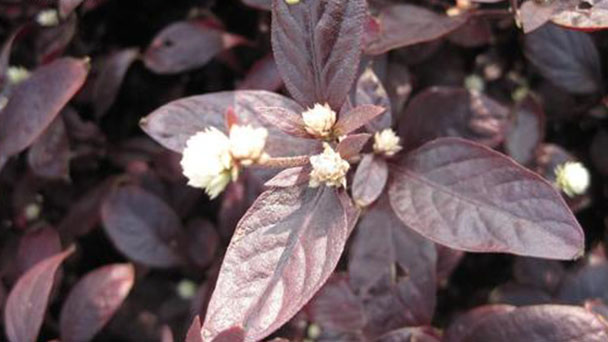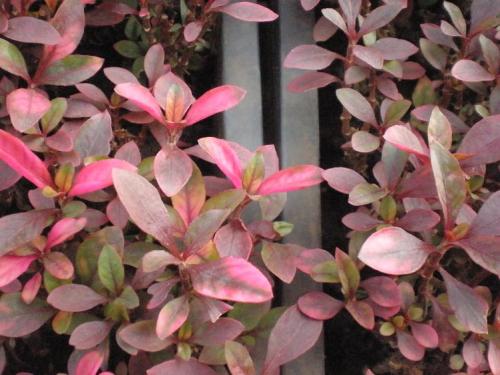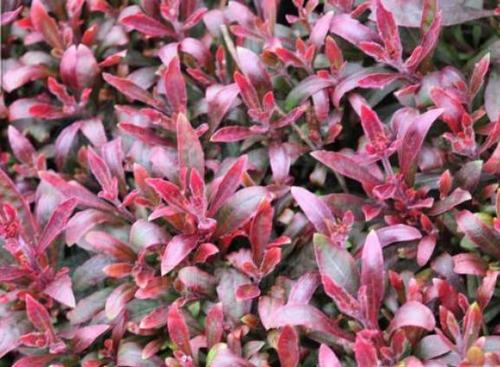Calico plant (Alternanthera bettzickiana) profile
Written by Maggie
Oct 30 2021

Calico-plant (Latin name: Alternanthera Bettzickiana) is a perennial herb in the genus Rosetrosperm of Amaranthus family. Because the leaves have a variety of colors, Calico-plant can be used for the arrangement of flower beds, arranged in a variety of patterns.
Calico-plant picture

Morphological characteristics of calico-plant
Calico plant (Alternanthera Bettzickiana) is a perennial herb, 20-50 cm tall; Stems are erect or base prostrate, much-branched, upper four prisms, lower cylindrical, on both sides each has a longitudinal groove, at the top and the section has attached health pubescent. Leaf-blade of Calico-plant is oblong, oblong obovate or spatulate, 1-6 cm long, 0.5-2 cm wide, apically acute or obtuse, convex, base tapered, margin undulate, green or red, or partly green, mixed with red or yellow markings, pubescent when young, glabrescent; Petiole of Calico-plant is 1-4 cm long, slightly pilose. Inflorescences are terminal to axillary, 2-5 fascicular, 5-10 mm long, without peduncles; Bracts and bracteoles of Calico-plant are ovate-lanceolate, 1.5-3 mm long, apex acuminate, glabrous or ridges villous; Perianth segments of calico-plant are ovate-oblong, white, outer 2 segments 3-4 mm long, concave, dorsal lower half densely spreading pubescent, middle 1 shorter, slightly concave or subflattened, sparsely pubescent or glabrous, inner 2 very concave, slightly shorter and narrower, sparsely pubescent or glabrous; Calico-plant has 5 stamens, filaments 1 -- 2 mm long, anthers striate, of which 1 -- 2 are short and sterile; Stamens of calico-plant are banding, middle or apical of anthers as high, apically divided into 3-5 very narrow strips; Ovary of calico-plant is glabrous, style ca. 0.5 mm. Fruit does not develop. (Find more Climbing Plants with Flowers here.)
Ecological habits of calico-plant
Calico plant (Alternanthera Bettzickiana) likes the sun, but also a little shade tolerance. Calico-plant likes higher temperature, but can not withstand the summer heat, afraid of the cold. There is a frost area for annual cultivation, overwintering mother plant needs 16-18. Calico-plant has strong adaptability to bed soil, the most suitable for loose bed soil. High temperature and high humidity or low temperature and high humidity easily cause seedling of calico-plant rot.
Calico-plant distribution area
Calico plant (Alternanthera Bettzickiana) originally produced in Brazil, now our country a big city cultivation.
Calico-plant method of propagation
The twigs with 2 nodes were picked as cuttings and inserted into sand, perlite or soil at a distance of 3cm. The temperature of the cuttings was 22-25℃. The roots of Calico plant (Alternanthera Bettzickiana) could be taken in 1 week and the plants could be transplanted in 2 weeks. Calico-plant does not produce seeds in the north, and cuttings are easy to take root, so cuttings are used to propagate. Used for arranging flower beds, usually, every square meter needs to be planted 350 to 500 Calico-plants, so it is necessary to plan in advance, timely cuttings.
Calico-plant growing methods
Usually use Calico plant (Alternanthera Bettzickiana) layout of patterned flower beds and three-dimensional sculpture flower beds, word composition, etc., with soil planting requirements, can be formed in a few days. Often trim during the calico-plant growing period, inhibit growth, so as not to disturb the design pattern. Drought timely watering, every other month to the leaf spray 2% nitrogen fertilizer once, in order to make the plant grow well, improve the ornamental effect.
Calico-plant function
Because the leaves of Calico plant (Alternanthera Bettzickiana) have a variety of colors, Calico-plant can be used for the arrangement of flower beds, arranged in a variety of patterns, the whole plant medicine, there are Qingrejiedu, cool blood hemostasis, clear product by stasis effect. Calico- Plant low standing, resistant to pruning. Leaves have red, yellow, green or purple-brown and other types, using the characteristics of resistance to pruning and different colors, often used in garden patterns, or "welcome to" and other sub-types. Calico-plant also can be used during the festival the potted plant of different color combinations becomes the theme pattern, in order to add the festive atmosphere.

Calico-plant related plants
Yellow Form alternanthera
'Yellow Form' Alternanthera is an easy-to-grow, tropical plant with a fast-spreading habit and pointed, chartreuse-yellow leaves. It forms a mat of color from spring’s frost-free date to fall’s first frost. Like others of this genus, it makes a great edging, bedding, or container plant. In formal landscapes, it can be used in a knot garden. It looks great with dark-leaved plants.
'Aureomaculatum' leopard plant
Green-and-yellow mottled, shiny, kidney-shaped leaves distinguish this evergreen perennial native to streamsides and seashores in East Asia. The large, leathery leaves can reach a foot across. The yellow flowers bloom in fall and winter, but they are small and secondary to the foliage. Farfugium are nice at waterside, as a groundcover, in a border, or in containers.
'Red Threads' alternanthera
Red Threads Alternanthera will grow to be about 8 inches tall at maturity, with a spread of 12 inches. Although it's not a true annual, this fast-growing plant can be expected to behave as an annual in our climate if left outdoors over the winter, usually needing replacement the following year. As such, gardeners should take into consideration that it will perform differently than it would in its native habitat.
This plant does best in full sun to partial shade. It requires an evenly moist well-drained soil for optimal growth, but will die in standing water. It is not particular as to soil type or pH. It is highly tolerant of urban pollution and will even thrive in inner city environments. Consider applying a thick mulch around the root zone over the growing season to conserve soil moisture. This is a selected variety of a species not originally from North America. It can be propagated by cuttings; however, as a cultivated variety, be aware that it may be subject to certain restrictions or prohibitions on propagation.
Red Threads Alternanthera is a fine choice for the garden, but it is also a good selection for planting in outdoor containers and hanging baskets. It is often used as a 'filler' in the 'spiller-thriller-filler container combination, providing a canvas of foliage against which the thriller plants stand out. Note that when growing plants in outdoor containers and baskets, they may require more frequent waterings than they would in the yard or garden.
Blue shrimp plant
lowers appear in a terminal, one-sided, bract-enshrouded cyme. In most members of the borage family the blooms are produced in what is called a “scorpoid cyme,” reminiscent of the arched tail of a scorpion. Though not as pronounced as some, you can still easily see the family resemblance.
Individual flowers are purple bells just under an inch long that begin appearing in late spring and continue until hot weather arrives. The leaf-like bracts subtending the flowers are purple-tinged and remain effective even after the plant is out of bloom.
Honeywort has been around, but it appears to have found a new audience in the past few years as people have become more interested in bees. In England it is being promoted as a bee plant by the Royal Horticulture Society.
First described and named by Linnaeus in the 1750’s, this plant has had an uncharacteristically stable history of no name changes. I find it mentioned by Bailey a century ago in his Cyclopedia, but none of my other garden references mention it, even as late as 2000. It seems to have survived as a pass-along plant in England and the Pacific Northwest where it self-sows enough to keep it around. Then with the interest in bees, it made its way back into the gardening world.
The association with bees is an old one. The Latin name is a translation from Greek of “wax” plus flower. Waxflower, an old name for the plant, was used because the ancients believed that bees collected wax from honeywort (another bee-associated name) to make their cones.
Honeywort is best grown much as you would grow broccoli. Plant the seeds inside in late winter and grow transplants with the aim of planting them out once the coldest weather of winter is past. Hardened plants should be able to take springtime frosts and freezes down to 20⁰F with no problems. It is easy to grow, tolerating an array of soils without fuss. It is best in full sun but will tolerate moderate shade.
Purple fountain grass
Purple fountain grass is aptly-named for the arcing spikes of purplish flowers that gracefully spray out of its mass of long, slender, burgundy-colored leaves. Native to Africa and Asia, it's technically a tropical ornamental grass, meaning it's not very cold-hardy, but is still well worth growing in cold-winter regions even if you can only enjoy it for two seasons out of the year. It has a fast growth rate and is best planted in spring.
The beauty of purple fountain grass makes it popular as a focal point in a mixed planting, and it is often used in container gardens. You can also mass several of the plants together to create a visually beautiful border or privacy screen. Because the autumn seed heads of this plant are so attractive, purple fountain grass, like maiden grass, is very useful in fall flower gardens. The feathery seed heads (or "plumes") can later be cut for dried flower arrangements.
Read Next:
Top 20 Climbing Plants with Flowers for Your Garden
Latest Updated
- Benefits of Bugleweed - 7 Science-backed Health Benefits
- Bugleweed Dangers & Side Effects - Is It Poisonous?
- How to Plant Evergreen Trees - What You Should Know
- When to Plant Evergreens - Grow Guide for Evergreen Trees
- 12 Wonderful Evergreen Shrubs for Your Garden
- 12 Popular Evergreen Plants with Pictures for Beginners
- When And How To Prune A Lilac Bush Like a Pro
- How to Grow & Care for Lilac Vine (Hardenbergia Violacea)
- Japanese Lilac Tree (Syringa Reticulata) Care & Propagation Guide
- Shumard Oak Pros and Cons - What to Know
Popular Articles
- Winter maintenance of Antirrhinum Majus
- How to Grow Terminalia Mantaly Tree
- How to Grow and Care for Crossostephium Chinense
- How to grow Antirrhinum Majus in spring
- Peristeria Elata (Dove Orchid) Profile: Info & Care Guide
- Underwatered Snake Plant (Sansevieria Trifasciata) - Signs And How To Fix
- How to Care for Brazilian Jasmine Plant (Mandevilla Sanderi)
- How to Grow & Care for Graptopetalum Purple Delight in Summer
- Rosa Chinensis (China Rose): Plant Growing & Care Tips
- How to Care for Baby Sun Rose (Aptenia Cordifolia)